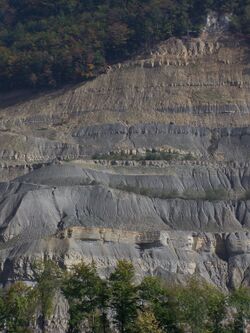الأكسفوردية (مرحلة)
| Oxfordian | ||||||||||||||
|---|---|---|---|---|---|---|---|---|---|---|---|---|---|---|
| 161.5 ± 1.0 – 154.8 ± 0.8 Ma | ||||||||||||||
 Cyclically alternating limestone (light, more competent) and marl/clay layers of Oxfordian age at Péry-Reuchenette, near Tavannes, Jura Mountains, Switzerland. | ||||||||||||||
| Chronology | ||||||||||||||
| ||||||||||||||
| Etymology | ||||||||||||||
| Name formality | Formal | |||||||||||||
| Usage information | ||||||||||||||
| Celestial body | Earth | |||||||||||||
| Regional usage | Global (ICS) | |||||||||||||
| Time scale(s) used | ICS Time Scale | |||||||||||||
| Definition | ||||||||||||||
| Chronological unit | Age | |||||||||||||
| Stratigraphic unit | Stage | |||||||||||||
| Time span formality | Formal | |||||||||||||
| Lower boundary definition | FAD of ammonite species Brightia thuouxensis | |||||||||||||
| Lower boundary definition candidates | Horizon of the Ammonite Cardioceras redcliffense. | |||||||||||||
| Lower boundary GSSP candidate section(s) | ||||||||||||||
| Upper boundary definition | FAD of the Ammonite Pictonia baylei | |||||||||||||
| Upper boundary GSSP | Flodigarry, Skye, Scotland, UK 57°39′40″N 6°14′44″W / 57.6610°N 6.2455°W | |||||||||||||
| GSSP ratified | 2021[1] | |||||||||||||
The Oxfordian is, in the ICS' geologic timescale, the earliest age of the Late Jurassic Epoch, or the lowest stage of the Upper Jurassic Series. It spans the time between 161.5 ± 1.0 Ma and 154.8 ± 0.8 Ma (million years ago).[2] The Oxfordian is preceded by the Callovian and is followed by the Kimmeridgian.
Stratigraphic definitions
The Oxfordian Stage was called "Clunch Clay and Shale" by William Smith (1815–1816); in 1818 W. Buckland described them under the unwieldy title "Oxford, Forest or Fen Clay". The term Oxfordian was introduced by Alcide d'Orbigny in 1844. The name is derived from the English city of Oxford,[3] where the beds are well developed, but they crop out almost continuously from Dorset to the coast of Yorkshire, generally forming low, broad valleys. They are well exposed at Weymouth, Oxford, Bedford, Peterborough, and in the cliffs at Scarborough, Red Cliff and Gristhorpe Bay. Rocks of this age are found also in Uig and Skye.[4]
The base of the Oxfordian Stage is defined as the point in the stratigraphic record where the ammonite species Brightia thuouxensis first appears. A global reference profile for the base (a GSSP) had in 2009 not yet been assigned. The top of the Oxfordian Stage (the base of the Kimmeridgian) is at the first appearance of ammonite species Pictonia baylei.
In the Tethys domain, the Oxfordian contains six ammonite biozones:
- zone of Epipeltoceras bimammatum
- zone of Perishinctes bifurcatus
- zone of Gregoryceras transversarium
- zone of Perisphinctes plicatilis
- zone of Cardioceras cordatum
- zone of Quenstedtoceras mariae
References
Notes
- ^ "Global Boundary Stratotype Section and Point". International Commission of Stratigraphy. Retrieved 25 July 2021.
- ^ "Stratigraphic Chart 2022" (PDF). International Commission on Stratigraphy. February 2022. Retrieved 22 April 2022.
- ^ Oxfordian is a word meaning "from Oxford" (see wiktionary:Oxfordian).
- ^ One or more of the preceding sentences incorporates text from a publication now in the public domain: Howe, John Allen (1911). . In Chisholm, Hugh (ed.). دائرة المعارف البريطانية. Vol. 20 (eleventh ed.). Cambridge University Press. p. 415.
{{cite encyclopedia}}: Cite has empty unknown parameter:|coauthors=(help)
Literature
- Brongniart, A.; 1829: Tableau théorique de la succession et de la disposition la plus générale on Europa, des terrains et roches, qui composent l'écorce de la terre, Paris.(in فرنسية)
- Gradstein, F.M.; Ogg, J.G. & Smith, A.G.; 2004: A Geologic Time Scale 2004, Cambridge University Press.
External links
- GeoWhen Database - Oxfordian
- Jurassic-Cretaceous timescale, at the website of the subcommission for stratigraphic information of the ICS
- Stratigraphic chart of the Upper Jurassic, at the website of Norges Network of offshore records of geology and stratigraphy
- مقالات المعرفة المحتوية على معلومات من دائرة المعارف البريطانية طبعة 1911
- Wikipedia articles incorporating text from the 1911 Encyclopædia Britannica
- Short description is different from Wikidata
- Articles with hatnote templates targeting a nonexistent page
- Pages using gadget WikiMiniAtlas
- Articles with فرنسية-language sources (fr)
- Oxfordian (stage)
- Oxfordian Stage
- Late Jurassic
- Geological ages
- 1827 introductions
- Culture in Oxford